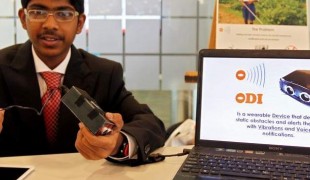- 8870
- 483
- 17
- 13
- 0
- Help Ukraine
About the solution
The device is worn like a pair of normal glasses. This gadget can “see” and understand the shapes of the objects around the user. It works by using a 3D scanner and vibrating sensors to help the user get around on their own. So it’s more about giving the user information about distances rather than colours or shapes.
Cornel was inspired by his parents. “I come from a family with members having a disability. I was able to help them to some extent, but in the end, I realised that handicaps really have no cure so far, particularly for blind or visually impaired people. These thoughts inspired me to design a special device that can help them”, the inventor said.
And how does it work? “Basically Lumen is an eyeglasses-based, wearable device that is aimed to help the blind in day to day life. It allows visually-impaired people to perceive the location of objects exactly like those with 20-20 vision, but it does so using tactile senses. More specifically, it uses the optical 3D scanner to map the environment in front of the user and transform it into an array of electric impulses that goes to the brain, which alerts the person of any obstacles in the way. In fact, after weeks of training, the user can actually regain about 10 % of the power of sight. Although Lumen cannot help people understand the colour or shape of the object, or they cannot tell the exact location of the keys on the keyboard, but they might be able to know it is a keyboard and how far it is without touching it”, he explained.
The solution operates in three different stages. “The first is to acquire the spatial characteristics of the environment by 3D scanning it using various types of sensors. In other words, we understand the distance to every object, its size, and the speed and direction of movement. We take all this information, process it in stage 2 and understand the most important aspects to inform the user about. Finally, in the third stage, the feedback stage, we represent the spatial characteristics of the environment through forehead vibrations. For example, if there’s an object to the left of the user, we’ll send a signal to the left side of the forehead saying how far the object is, its speed and its shape”, the man observed.
The invention is now being submitted to public testing and the idea is to make it available on the market so that people can benefit from it.
Cornel is the Head of Innovation at Continental Automotive Systems in Bremen, Germany. He started working on Lumen in 2013. Since then, he was selected as one of the 10 standout members of Forbes 30 under 30 Europe and received the 2016 Innovation and Technology Leadership Award from the Aspen Institute.
Adapted from: https://bit.ly/32bvtEQ
https://bit.ly/2FPezSM
https://exxonmobil.co/2rWItOi
https://bit.ly/2YwKQ8z
https://bit.ly/30cJ5xQ
https://www.youtube.com/watch?v=7Lrsqe5YYQU
This solution shall not include mention to the use of drugs, chemicals or biologicals (including food); invasive devices; offensive, commercial or inherently dangerous content. This solution was not medically validated. Proceed with caution! If you have any doubts, please consult with a health professional.
DISCLAIMER: This story was written by someone who is not the author of the solution, therefore please be advised that, although it was written with the utmost respect for the innovation and the innovator, there can be some incorrect statements. If you find any errors please contact the patient Innovation team via info@patient-innovation.com
-
-
496
-
0
-
6924

Student invents device to help his visually impaired family members
-
-
-
337
-
0
-
3636

Student creates device to help visually impaired people identify objects
-
-
-
768
-
1
-
11660

Teen creates device for the visual impaired
WALKING: Walking
Blindness
5 Senses support devices: (glasses, hearing aids, headphones...)
Assistive Daily Life Device (to help ADL)
Body-Worn solutions (Clothing, accessories, shoes, sensors...)
App (Including when connected with wearable)
Vision problems
Difficulty coordinating movements
Managing Neurological Disorders
Caregiving Support
Neurology
Ophthalmology
United Arab Emirates
-
 en
en